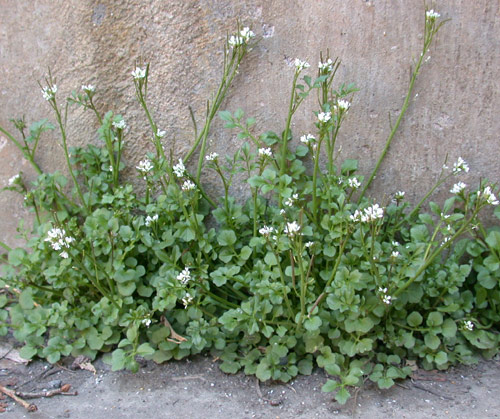
Hairy Bitter Cress growing along a wall in Savannah Georgia in December. Photo by Green Deane
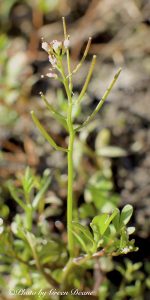
Hairy Bitter Cress had “tooth pick” seed pods. Photo by Green Deane
Members of the mustard family usually like cooler weather. They are a spring and summer plant in northern places like Canada. They’re a fall and winter plant in southern climates. There are big mustards and little mustards, some three or four feet tall, others that barely break a foot. One good thing about the managerie is that there are no toxic mustards. No matter where you are in the world, if it is in the mustard family it’s edible. This is not to say there are no warnings even if edible. Some mustards are strong flavored thus better cooked than eaten raw. Indeed when I made my life move from Maine to Florida I left behind a mild mustard I could eat raw. What I found here was a strong wild radish that I must cook or the stomach aches. Farm animals also have varying responses to the mustard clan. That can range from irritated digestive systems to mustard-tasting milk. So while mustards are comestibles some caution is reasonable for you and your livestock.
Locally the big mustards, such as Wild Mustard and Wild Radish, don’t sprout for another month or so and can be found around Christmas into the new year. Some of the Little Mustards can be found now. During a foraging class this past weekend in Orlando we found Hairy Bitter Cress. It’s a mustard member one can find for seven or eight months or all but the hottest time of the year. Botanically Cardamine hirsuta (which means Hairy Cress) it’s a nice addition to salads and the like. The entire plant’s edible. It likes disturbed soil, and in warmer months close to water and drying stream beds. Unlike Swine Cress, it is not a common lawn plant. It’s extremely common in pots and around plant nurseries. You can read about it here.
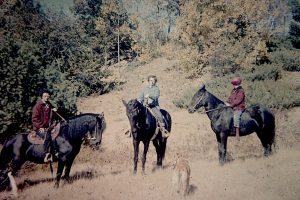
Horses don’t like plants in the mustard family — it’s toxic to them — so the seeds collected in the chaff in the hay barn. (That’s my mother on Ginger, left, Lois Curit on Bonny, center, and me on Chico. The dog is Rex. Photo by Robert Hartley Jordan
(If I may continue the mustards as an aside: Way back in the late 50s and early 60s my father built our house and barn in Pownal, Maine. For modern folks that’s about five miles west of L.L. Bean. Pownal, which has only 400 more citizens today than it did 160 years ago, has some king-decreed untaxable land that has been passed down eldest son to eldest son since the 1600s. It has caused centuries of legal problems. No taxes no services such as fire or electricity… Anyway, our place had no “lawn” for several years as lawns aren’t a priority out in the country. Early one spring my father took wheel barrows full of chaff from the hay barn and spread it out where the lawn was supposed to be. By the time school let out the lawn was a jungle of tall mustard plants that gave away over the summer to tall lambs quarters, all edible. It took many years to convince grass to grow there. Grass has to be coaxed and pampered to survive, weeds take care of themselves I have a video about large mustards here.)
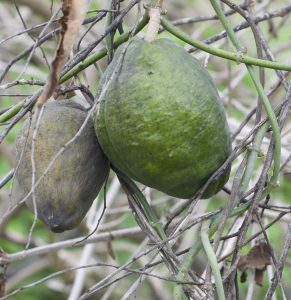
Younger fruit is preferable than older fruit. Photo by Green Deane
Now is also a good time to look for last-of-the-season fruit that sounds like it was the star of a 1950’s sci-fi film: Latex strangler Vine. The fruit — which is used like a vegetable — is easy to describe: It looks like a smaller, greener chayote. That only helps if you know what a chayote looks like. It’s a light green vegetable usually found in the grocery store with the squashes. It has an unmistakeable butt crack, a fold along the entire bottom. Does one have to say the state of Florida and native plant societies loathe the vine? Its main horror was to cover citrus trees with shade until the tree died. That might become a moot point as greening removes citrus from the peninsula’s landscape. Millions was spent trying to eradicate the vine without success. Indeed, the best place to find Latex Strangler Vine is in or around citrus groves. And as there are thousands of acres of untended citrus groves it is a relatively easy vine to spot. You can also locate it readily on fences. The vine does have latex so it is one of the few plants with a milky sap that we do eat. And nearly all of the plant is edible one way or another except the root. There are two warning of sorts. The fruits get tough as they age and in time will dry, break open, and spread milkweed-like seeds. At some point it becomes too dry and tough — mature — for us to eat. That is when we don’t eat the seeds or coma. And the entire plant is toxic to cows. I have a video about it here. To can read about go the vine here.
Perhaps it is time to revisit Bacopa. This weekend from Sarasota to Orlando the species was happy, abundant and blossoming. We actually have two Bacopas locally. The one we are interested in is very common. The other, which actually tastes better, is harder to find but may not have the proven beneficial affects.
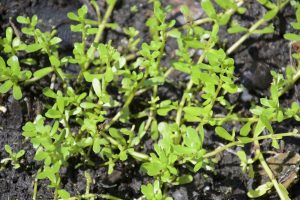
Bacopa monnieri resembles purslane. Photo by Green Deane
Bacopa monnieri, aka Water Hyssop but known universally in health food stores as Bacopa, is bitter. It is not a wild edible most will like. But, as a medicine it is a wonder drug so to speak. What does it do? It coaxes the brain into making new memory cells. A double-blind study — the gold standard — showed 12 weeks of supplementation with Bacopa monnieri improved the memory and executive functions dramatically and permanently in 65-year olds who were having such problems. However as one does not lose function overnight recovery is not overnight. It took at least three months of daily supplementation to improve those functions. Bacopa is also anti-inflammatory. I personally know four people who took Bacopa monnieri for memory issues and had significant improvement. Best of all if it works for you it grows wild here. Its relative, Bacopa caroliniana, is called Lemon Bacopa. That Bacopa makes a nice tea that tastes like lime and is probably not good for you at all. I have video on the Bacopas here. You can read about Bacopa monnieri here.
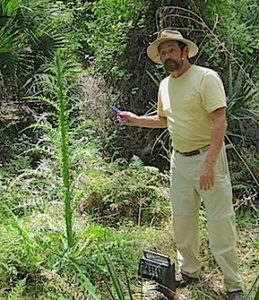
Foraging classes are held rain or shine. Photo by Nermina Krenata
Foraging Classes: This weekend classes are on both sides of the state, Melbourne and Port Charlotte. Each location has its own particular uniqueness.
Saturday, October 28th, Wickham Park, Wickham Park: 2500 Parkway Drive, Melbourne, FL 32935-2335. 9 a.m. Meet at the “dog park” inside the park.
Sunday, October 29th, Bayshore Live Oak Park, Bayshore Drive. Port Charlotte. 9 a.m. Meet at the parking lot at the intersection of Bayshore Road and Ganyard Street.
Saturday, November 4th, Blanchard Park, 10501 Jay Blanchard Trail, Orlando, FL 32817. 9 a.m. Meet at the covered picnic table by the tennis courts near the WMCA building.
The read more about the classes go here.

Foraging DVDs
All of Green Deane’s videos available for free on You Tube. They do have ads on them so every time you watch a Green Deane video I get a quarter of one cent. Four views, one cent. Not exactly a large money-maker but it helps pays for this newsletter. If you want to see the videos without ads and some in slightly better quality you can order the DVD set. It is nine DVDs with 15 videos on each for a total of 135 videos. Many people want their own copy of the videos or they have a slow service and its easier to order then to watch them on-line. The DVDs make a good gift for that forager you know especially on long, cold winter months. Individual DVDs can also be ordered or you can pick and choose. You can order them by clicking on the button on the top right of this page. If it is not working — the site is under construction and being updated — you can go here.
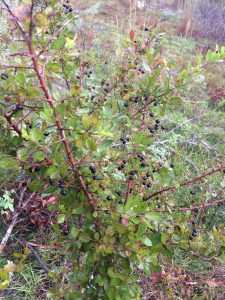
Do you know this plant? You would if you read the Green Deane Forum
Want to identify a plant? Looking for a foraging reference? Do you have a UFO, an Unidentified Flowering Object you want identified? On the Green Deane Forum we chat about foraging all year. And it’s not just about warm-weather plants or just North American flora. Many nations around the world share common weeds so there’s a lot to talk about. There’s also more than weeds. The reference section has information for foraging around the world. There are also articles on food preservation, and forgotten skills from making bows to fermenting food. One special section is “From the Frightening Mail Bag” where we learn from people who eat first then ask questions later. You can join the forum by clicking on the button on the upper right hand side of this page.
This is issue 275.
If you would like to donate to Eat The Weeds please click here.

